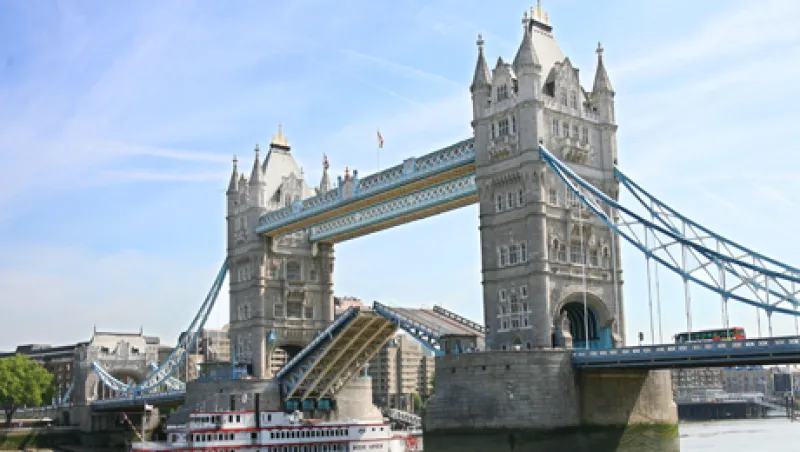April has seen the recurrence of a time-honored, though not well-loved, spring ritual in the U.K: Seven water authorities have imposed hosepipe bans on irate customers. The businesses blamed unusually dry weather for a depletion of water reserves. Their clients blamed the companies’ aged, leaking infrastructure.
A few days later came a glimmer of hope for the long term for Britons fed up with moistening their treasured gardens through manual labor. London boroughs announced they were in talks to create a citywide pension fund out of the 32 small borough schemes. One of the key advantages, according to proponents, was that a pooled scheme would be large enough to invest more than £2 billion ($3.2 billion) in local infrastructure projects. London’s water system is a prime candidate. More than 40 percent of the water mains are more than a century old — a legacy of the Victorian era’s mania for grand building projects.
Many of Britain’s pension schemes are too small to invest in infrastructure. They lack the money to create a balanced portfolio of investments within this asset class; they cannot afford to hire the specialist personnel needed for the time-consuming business of assessing the economic viability of infrastructure projects. For London boroughs, a large pooled fund would circumvent both obstacles.
Partly because of this problem of scale, only 1.1 percent of U.K. defined-benefit schemes’ assets are in infrastructure, according to 2011 figures from the National Association of Pension Funds — not much higher than the 2009 share of 0.9 percent.
But once the problem of scale has been overcome, does the emerging asset class of infrastructure have the ability to generate decent returns for pension funds as well as deliver improvements in services for citizens?
The opportunities for investment are certainly abundant — both in Britain, whose government is increasingly trying to find private-sector funding for public projects in response to its huge debt, and internationally, as emerging economies expand their infrastructure to cope with rapid economic growth. Governments know they need more — or at the very least more up-to-date — infrastructure, but they increasingly lack the means to build and operate it all.
The U.K. government has estimated that in the next five years, U.K. infrastructure will require about £200 billion in investment, largely in transport and energy, and it expects 70 percent of this to come from the private sector. In a March report, the Organization for Economic Cooperation and Development calculated that between 2009 and 2030 the world will need $11 trillion in funding for “strategic transport” infrastructure, including airports, rail and oil and gas distribution.
For pension funds, the investment attraction of infrastructure derives largely from one reassuring principle. It is, by definition, essential — if one assumes that government is doing a competent job of assessing need. For a pension fund investing with a long-term horizon, this increases the likelihood that it can expect a regular stream of payments from users over the life of the infrastructure asset that they are patronizing.
Infrastructure is all the more attractive because of the increasing interest among many U.K. pension funds in asset-liability management. They are taking greater care each year to match the total sum of annual pension payments due to scheme members with total income from investments. A well-chosen infrastructure project is highly cash-generative, and the generation of that cash is regular and predictable.
An added bonus for U.K. pension funds is that in many cases across the world, returns on infrastructure projects are linked to inflation because maximum permitted charges to customers are often based on the national consumer price index. This allows even closer asset-liability matching, since defined-benefit funds’ payments to members are also commonly inflation-based.
Analysts warn, however, that infrastructure investment presents many of the same pitfalls as other asset classes — plus a few of its own.
Like with equities, direct infrastructure investment, whether through specialist funds or through government project backing, can have both a low and an exceedingly high correlation with economic growth. People will always need facilities to process their sewage, regardless of economic conditions. By contrast, the volume of road use is often extremely sensitive to income and employment, and particularly so if drivers must pay directly for it. This makes investment in toll roads a riskier strategy.
One solution is to invest in projects where the customer is the government — which has customarily agreed to pay preset charges regardless of economic growth or rates of usage. This category includes the many billions of privately funded pounds spent on building and maintaining hospitals and schools in the U.K. since the early 1990s.
But this solution presents a brand-new problem: political risk. In 2010, the new Conservative-Liberal Democrat coalition government scrapped Building Schools for the Future, the U.K. government’s partnership program with the private sector to rebuild secondary schools. A £16.2 billion agreement with the private sector to improve the London Underground subway system ended in 2010 after years of politically charged acrimony.
A partial solution to the political risk is for pension funds to invest in broadly based, large-cap equities that will benefit from the infrastructure boom but are less directly exposed to the political risks of individual projects. Within the FTSE 100 these include Serco, which runs infrastructure on behalf of governments, and Wolseley, the building materials company.
However, investing in infrastructure-related equities defeats one of the main attractions of infrastructure investment: In a world where assets as diverse as equities, Italian government bonds and even gold are increasingly prone to rise and fall in value at the same time, for all its faults, direct infrastructure investment shows a low correlation with other asset classes. This will remain the case, at least, until it wins full acceptance among pension funds — at which point it risks becoming yet another asset class whose value plummets when pension funds make forced sales at times of financial market turbulence.






